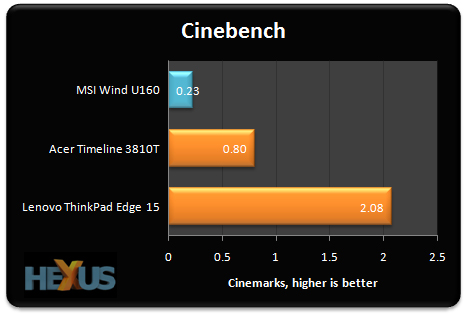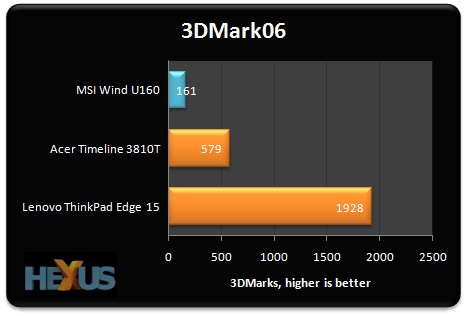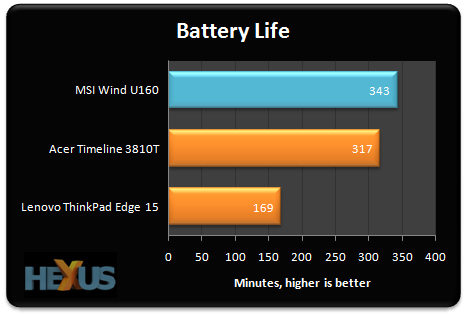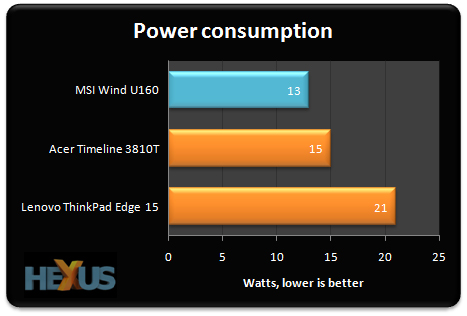Performance
MSI's Wind U160 is the first netbook to pass through our revamped benchmark suite, and we'll consequently be providing comparative numbers from a 13.3in Intel Core 2 CULV notebook, the Acer Timeline 3810T, as well as a 15.6in Core i5 machine, Lenovo's ThinkPad Edge 15.
With system prices starting at around £330, £500 and £700, respectively, our three portables are by no means directly comparable but the benchmark results should illustrate the trade offs in performance and battery life as you move up through the Intel CPU hierarchy.
| Comparison systems | |||
|---|---|---|---|
| Laptop | MSI Wind U160 | Acer Timeline 3810T | Lenovo ThinkPad Edge 15 |
| Processor | Intel Atom N450 (1.66GHz, 512KB L2 cache, single-core) | Intel Core 2 Duo SU9400 (1.40GHz, 3MB L2 cache, dual-core) | Intel Core i5 430M (2.26GHz, 3MB L3 cache, dual-core) |
| Memory | 1GB DDR2 667MHz | 2GB DDR3 800MHz | 4GB DDR3 1,066MHz |
| Graphics | Intel GMA 3150 | Intel GMA 4500MHD | Intel HD Graphics |
| Graphics driver | Intel 8.14.10.2117 | Intel 7.15.10.1666 | Intel 8.15.10.2057 |
| Display | 10.0in - 1,024x600 | 13.3in - 1,366x768 | 15.6in - 1,366x768 |
| Battery | 6 cell, 65Whr | 6 cell, 56Whr | 6 cell, 48Whr |
| Weight | 1,237g (including battery) | 1,645g (including battery) | 2,476g |
| Wireless | Ralink 1T1R (802.11bgn) and Bluetooth 2.0 | Intel WiFi 5100 (802.11bgn) and Bluetooth 2.0 | Intel WiFi Link 1000 (802.11bgn) and Bluetooth 2.1 |
| Disk drive | Seagate Momentus 250GB, 5,400RPM, 8MB cache | Hitachi 500GB, 5,400RPM, 8MB cache | Seagate Momentus 320GB, 5,400RPM, 8MB cache |
| Optical drive | None | None | Dual-layer DVD recorder |
| Operating System | Microsoft Windows 7 Starter, 32-bit | Microsoft Windows 7 Home Premium, 32-bit | Microsoft Windows 7 Professional, 64-bit |
| Benchmarks | |||
| Geekbench 2.1.6 | A cross-platform benchmark used to measure memory and processor performance. Run using high-performance mode. | ||
| Cinebench 11.5 | Using Cinebench's multi-CPU render, this cross-platform benchmark stresses as many cores as possible. Run using high-performance mode. | ||
| 3DMark06 | A PC benchmark used to test the DirectX 9 performance of a system's graphics card. Run using high-performance mode. | ||
| Battery test | In order to measure battery life, we run the notebook on balanced power settings and loop a 720p movie trailer, measuring the time taken to hibernate. | ||
| Power consumption | Using balanced power settings, we record mains power draw whilst playing back a 720p movie trailer. | ||
CPU and GPU performance



As expected, the Intel Atom-powered Wind U160 offers very, very basic CPU and GPU performance.
Despite the introduction of the second-generation "Pine Trail" architecture, the performance gap between the 1.66GHz Atom N450 and the Core 2 Duo part remains immense.
Don't be too disheartened by the numbers, though. The Wind U160 isn't designed to bust through benchmarks. During everyday use we found the system to be adequately responsive to most common tasks. Applications load promptly, multi-tasking with a few open windows isn't a problem and web browsing is generally fluent and smooth.
As an aside, it's worth noting that Intel's integrated graphics processor - the GMA 3150 - offers basic non-3D hardware acceleration for codecs such as MPEG2, but not for the ubiquitous Flash format. Consequently, HD videos on popular websites such as YouTube are prone to stuttering; an experience netbook users are no doubt familiar with.
Battery life and power consumption


Longevity is where the Wind U160 really shines. During regular use, we managed to go almost nine hours of juice from the big 65Whr battery on a balanced power mode with screen brightness set to 60 per cent.
That's still hours short of MSI's quoted figure of "up to 15", but plenty to last throughout the average working day. The notebook does offer an "Eco" mode that will no doubt further extend battery life, but we found the mode's preset screen brightness to be almost unreadable.
During heavy use - in this case playing back a looped 720p movie trailer - the Wind U160 kept running for a useful 5 hours and 43 minutes before entering hibernation. Watching back-to-back movies on this little system shouldn't be a problem.









